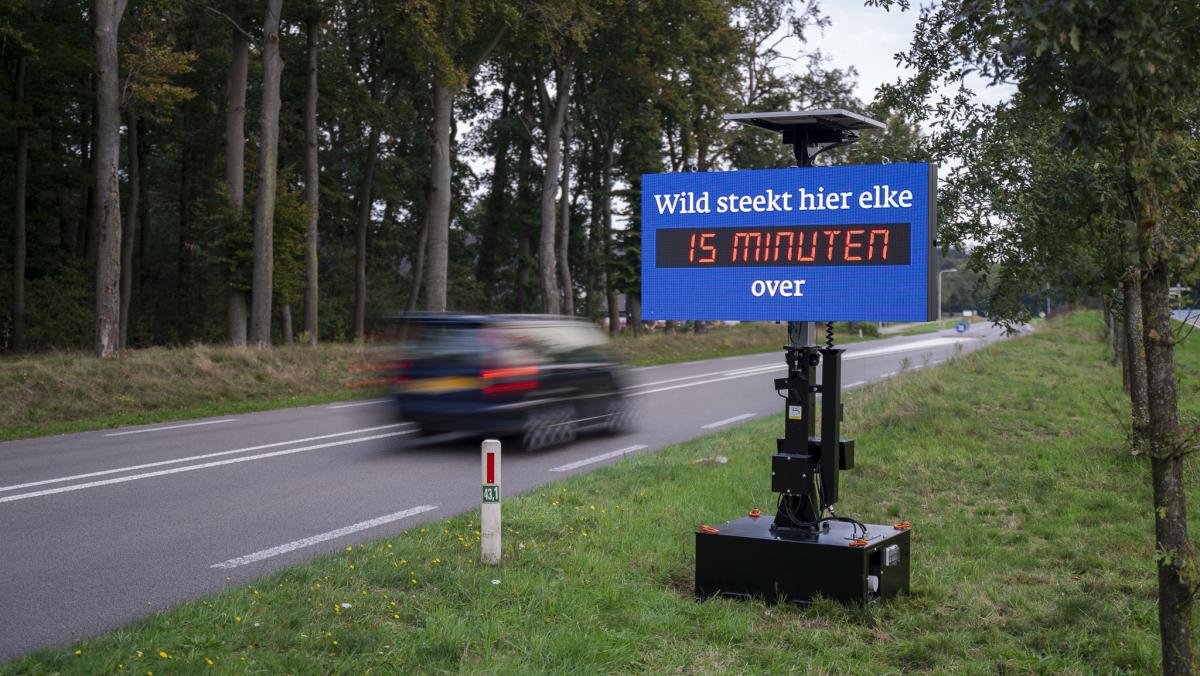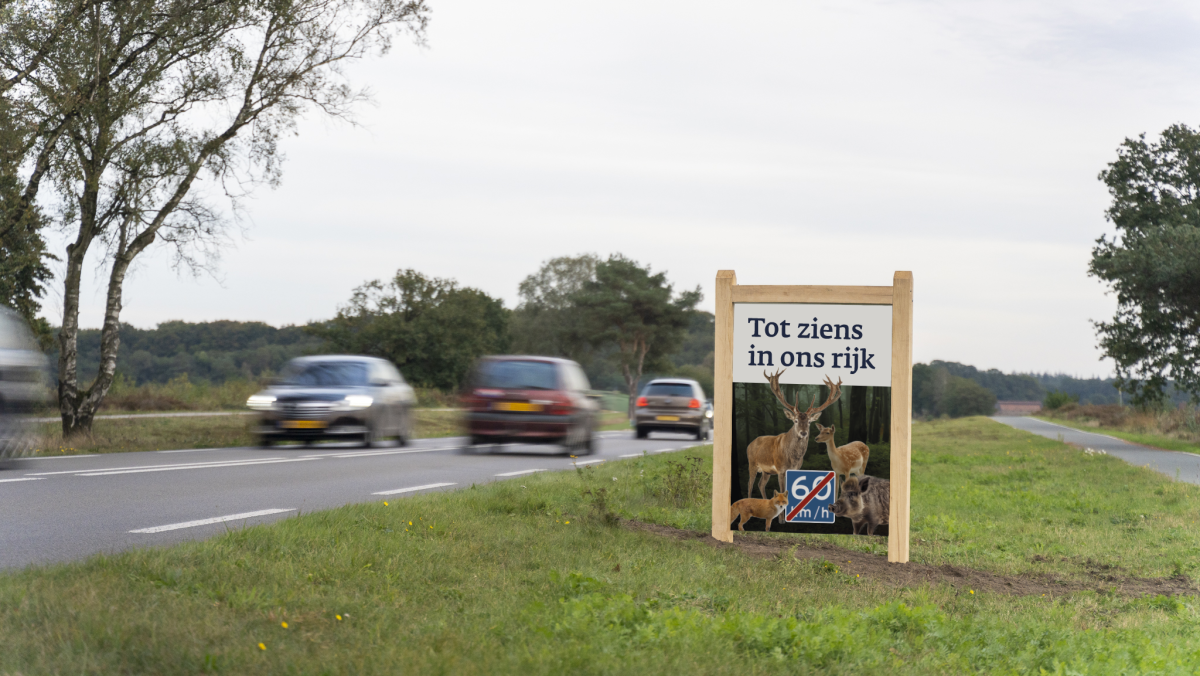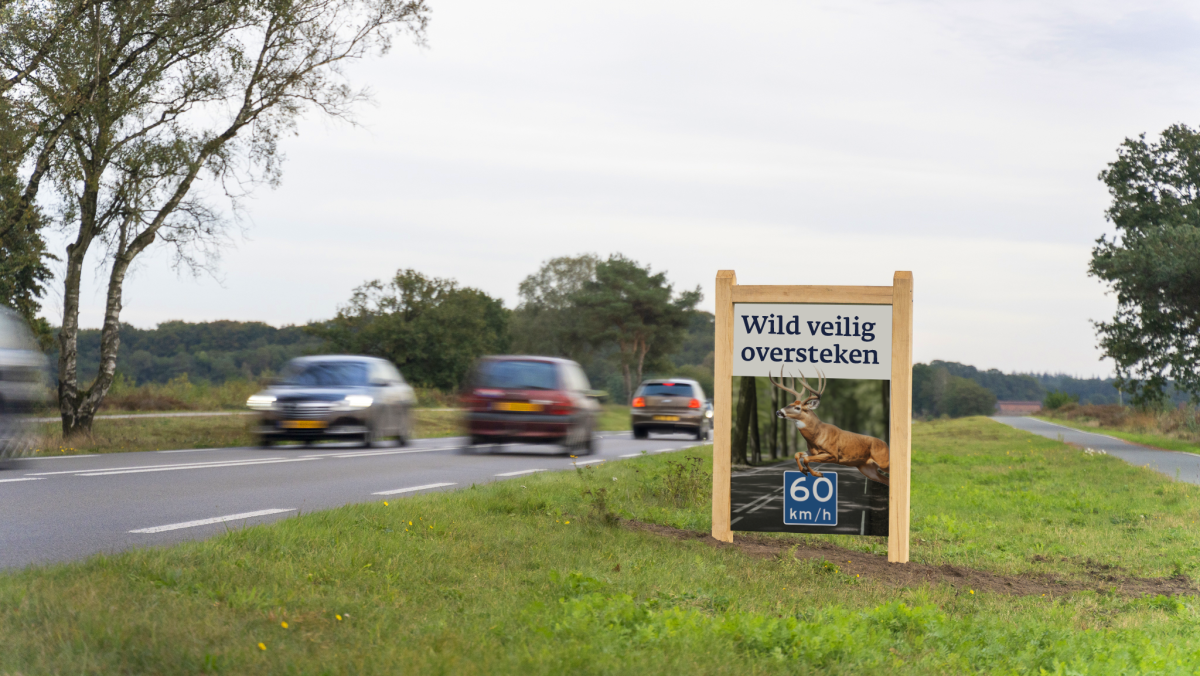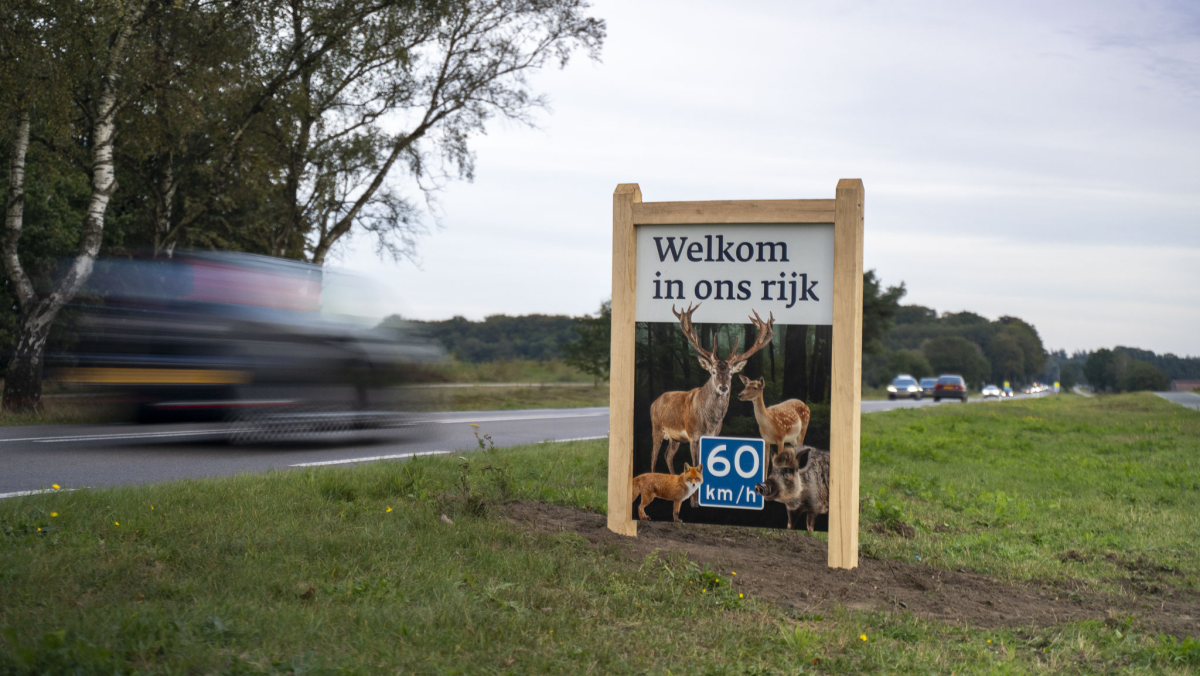Initiative details
Nature in Gelderland is thriving, with a growing number of wild animals. This is a beautiful phenomenon, but unfortunately, it also brings an increased risk of accidents involving wild animals. The chances of a poor outcome for the animal are high, but there is also a significant risk of material damage and severe consequences for the driver. The risk of collisions with wildlife is especially higher during certain periods, specific times, and at certain locations. Think of dawn and dusk, and the transition to winter or summer time.
In the past, the Province of Gelderland has taken various measures by adjusting the infrastructure and influencing the behavior of wild animals. Examples of these measures include the installation of warning signs, wildlife grids, and boar disappearance blocks. However, it turns out that more is needed to tackle the problem.
Drivers often underestimate the risk of animals being along the roads in the forests. Despite the recommended speed limits, they often drive too fast and are not always aware of the risk of animals along the roads. Therefore, the province of Gelderland wants to place more emphasis on the behavior of road users. In response to this need, creative behavioral agency andc and behavioral agency Dijksterhuis and Van Baaren have developed a behavior-oriented approach, including interventions, to encourage road users to adhere to the recommended speed limits.
In the past, the Province of Gelderland has taken various measures by adjusting the infrastructure and influencing the behavior of wild animals. Examples of these measures include the installation of warning signs, wildlife grids, and boar disappearance blocks. However, it turns out that more is needed to tackle the problem.
Drivers often underestimate the risk of animals being along the roads in the forests. Despite the recommended speed limits, they often drive too fast and are not always aware of the risk of animals along the roads. Therefore, the province of Gelderland wants to place more emphasis on the behavior of road users. In response to this need, creative behavioral agency andc and behavioral agency Dijksterhuis and Van Baaren have developed a behavior-oriented approach, including interventions, to encourage road users to adhere to the recommended speed limits.
Initiative date
to
Who was/is your target audience?
Policy makers
Public authorities
Car drivers
Topic
Create awareness
Provide alternative solutions
Organisation details
andc
Enterprise
Netherlands
Nijmegen
Contact name
Ron Ghijssen
Telephone number
+31655153230
ron@andc.nl
Website link
Project activities
If you work together with external partners, list the most important partners and briefly describe their role.
Behavioral research agency Dijksterhuis & van Baaren was important because they developed the behavior strategy on which the interventions are based. The client, Province of Gelderland, was a key partner as they were actively involved in the development of the interventions and facilitated where we could place the interventions.
Please describe the project activities you carried/are carrying out and the time period over which these were implemented.
Based on a behavior strategy developed by behavioral scientists, we implemented the following interventions from mid-October to mid-November.
The Concept
To prevent the recipients of the message from feeling resistance towards the sender, it was decided to communicate the message from the animals themselves. Animals are generally loved by people and this way they are given a voice they do not actually have. Moreover, communicating from the perspective of animals draws extra attention. The risk area is framed as 'the realm of the animals'.
Welcome Pillar
Upon entering the risk area, road users first pass a welcome pillar. This pillar marks the beginning of the risk area by having animals from the realm welcome the road user. In this way, the road user is essentially a guest in the area. This approach is important from a behavioral perspective because people feel less anonymous and are more likely to exhibit the desired behavior when they feel like guests. By also indicating the recommended speed on the welcome sign, the road user is made aware of the expected behavior.
Dynamic Message
After passing the welcome pillar, road users see a dynamic message. Based on data obtained by the Province of Gelderland, the probability of crossing wildlife is displayed in minutes on a self-sufficient screen. The number of minutes shown on the screen varies depending on the time of day. Because this time is adjusted remotely and automatically, the risk of possible crossing animals is made visible, which enhances the perception of risk.
Motto Board
The advisory speed shown on the welcome pillar is repeated on the motto board. This repetition ensures that the road user is more frequently exposed to the desired behavior. By depicting the red deer - as prominent wildlife - jumping towards the road, the perception of risk is also increased. The term "safely crossing wildlife" is a playful pun that attracts the road user's attention.
Silhouettes
To make road users aware of the possibility that wildlife can actually cross the road, silhouettes have been placed in the risk area. These silhouettes are positioned facing the road, enhancing the feeling that animals might cross. The silhouettes draw attention and simultaneously increase risk perception.
Closing Pillar
The set of interventions concludes with a closing pillar. The wild animals bid farewell to motorists, marking the end of the risk area. The sign clearly indicates that the advisory speed limit of 60 km/h no longer applies. It is important to demarcate the area in this way, as clearly setting boundaries can encourage the desired behavior.
The Concept
To prevent the recipients of the message from feeling resistance towards the sender, it was decided to communicate the message from the animals themselves. Animals are generally loved by people and this way they are given a voice they do not actually have. Moreover, communicating from the perspective of animals draws extra attention. The risk area is framed as 'the realm of the animals'.
Welcome Pillar
Upon entering the risk area, road users first pass a welcome pillar. This pillar marks the beginning of the risk area by having animals from the realm welcome the road user. In this way, the road user is essentially a guest in the area. This approach is important from a behavioral perspective because people feel less anonymous and are more likely to exhibit the desired behavior when they feel like guests. By also indicating the recommended speed on the welcome sign, the road user is made aware of the expected behavior.
Dynamic Message
After passing the welcome pillar, road users see a dynamic message. Based on data obtained by the Province of Gelderland, the probability of crossing wildlife is displayed in minutes on a self-sufficient screen. The number of minutes shown on the screen varies depending on the time of day. Because this time is adjusted remotely and automatically, the risk of possible crossing animals is made visible, which enhances the perception of risk.
Motto Board
The advisory speed shown on the welcome pillar is repeated on the motto board. This repetition ensures that the road user is more frequently exposed to the desired behavior. By depicting the red deer - as prominent wildlife - jumping towards the road, the perception of risk is also increased. The term "safely crossing wildlife" is a playful pun that attracts the road user's attention.
Silhouettes
To make road users aware of the possibility that wildlife can actually cross the road, silhouettes have been placed in the risk area. These silhouettes are positioned facing the road, enhancing the feeling that animals might cross. The silhouettes draw attention and simultaneously increase risk perception.
Closing Pillar
The set of interventions concludes with a closing pillar. The wild animals bid farewell to motorists, marking the end of the risk area. The sign clearly indicates that the advisory speed limit of 60 km/h no longer applies. It is important to demarcate the area in this way, as clearly setting boundaries can encourage the desired behavior.
In terms of implementation, what worked well and what challenges did you need to overcome?
The implementation went smoothly. The dynamic screen operates on solar energy and a battery. During the pilot, we had to monitor whether the system had sufficient energy. We had to replace the battery once due to insufficient solar yield. Otherwise, everything went as planned.
Evaluation
Please summarise how you have evaluated the initiative’s impact (e.g. social media reach, survey, feedback forms, statistics).
To determine the impact of the interventions, the effect of the interventions on the speed of motorists (in km/h) was measured. The measurements were carried out on three different roads: the N224, the N795, and the N797. All three are 80 km/h roads but have an advisory speed limit of 60 km/h.
Research Design
To make the effects of different components of the interventions clear, we chose a research design where a different combination of measures was implemented for each N-road. The N224 was the only road where the entire set of interventions was applied. On the N795, all interventions except the dynamic sign were implemented, while the N797 served as a control location with no interventions applied.
Research Design
To make the effects of different components of the interventions clear, we chose a research design where a different combination of measures was implemented for each N-road. The N224 was the only road where the entire set of interventions was applied. On the N795, all interventions except the dynamic sign were implemented, while the N797 served as a control location with no interventions applied.
What has been the effect of the activities?
Measurements
After a pre-measurement and two post-measurements - one before and one after the clock was set back to winter time - the results became clear. The interventions had a real effect. On the two roads where the interventions were placed, a reduction in speed was observed.
On the N224 (all interventions), motorists drove on average 3.64 km/h slower in the short term. In the long term, they drove on average even 5.19 km/h slower.
On the N795 (all interventions except the dynamic message), the average speed decreased by 3.81 km/h in the short term and 2.84 km/h in the long term.
The speed at the control location (N797) remained almost the same.
The results show that the interventions clearly had an effect on the speed of motorists, with the dynamic message proving crucial for reducing speed in the long term.
After a pre-measurement and two post-measurements - one before and one after the clock was set back to winter time - the results became clear. The interventions had a real effect. On the two roads where the interventions were placed, a reduction in speed was observed.
On the N224 (all interventions), motorists drove on average 3.64 km/h slower in the short term. In the long term, they drove on average even 5.19 km/h slower.
On the N795 (all interventions except the dynamic message), the average speed decreased by 3.81 km/h in the short term and 2.84 km/h in the long term.
The speed at the control location (N797) remained almost the same.
The results show that the interventions clearly had an effect on the speed of motorists, with the dynamic message proving crucial for reducing speed in the long term.
Please briefly explain why your initiative is a good example of improving road safety.
The behavior-oriented approach has been proven effective in reducing the risk of wildlife collisions. Through targeted interventions and clear communication, drivers can be encouraged to adhere to the recommended speed limits, thus creating a safer environment for both humans and animals.
How have you shared information about your project and its results?
We presented the results at the national traffic safety congress in March of this year. Additionally, we held several online sessions in which we shared the results with a broad audience.
Supporting materials





